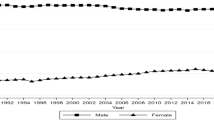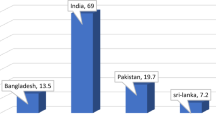Abstract
The number of non-farm proprietorships in the US has expanded significantly in past decades, but this expansion has not occurred evenly over space. Regression analysis correcting for spatial autocorrelation reveals that proprietors respond rationally to economic incentives. Parameter estimates for variables measuring collateral, age, ethnic mix, government policy, female labor force participation, and natural amenities, each have the expected signs. A few options are available to policymakers for influencing growth in self-employment densities over time.



Similar content being viewed by others
Notes
The data are from the Regional Economic Information System, Bureau of Economic Analysis, US Department of Commerce, Washington, DC; ordering information for the compact disc is available at: http://www.bea.gov/bea/regional/docs/cd.asp. Nation-wide (rural and urban areas), the number of non-farm proprietorships increased from 12.3 to 27.8 million, with the share of proprietors in all jobs nationally rising by more than 50%, from 10.5% to 15.4%. In this study, “rural” and “non-metro” are used interchangeably, as are the terms proprietorship and self-employed. According to the Current Population Survey (2004 March Supplement), the proprietors work in these industries (ranked by order of importance): services, construction, retail, FIRE, manufacturing, transportation and public utilities, wholesale, and information (Low et al. 2005). Given the data limitations, we are largely unable to examine differences across scales of proprietorship operations, and this is one shortcoming of the analysis; in terms of sector detail, we control for construction, services, retail trade, and high-tech employment, and assume that these operate as intercept rather than slope shifters.
In particular, the degree of risk acceptance and creativeness or innovativeness likely distinguishes true entrepreneurs from the self-employed, and so the analogy between the two types of individuals is not without problems. We draw on the entrepreneurship literature to generate maintained hypotheses for variables to include in the regression.
This assumption may not fully explain the decisions of rural people. They may be willing to give up some level of income (wealth) to live in rural areas. In a spatial world, income maximizing individuals would simply move out of rural areas, but many choose not to. Researchers have suggested that because of lower opportunity costs, rural business owners are willing to accept lower rates of return. This possibility is embedded in our model as shift factor τ.
We are grateful to an anonymous reviewer for this point.
To compare our results with those of previous studies, we also included shares of different ethnic groups in a separate regression. This is discussed in the results section.
We thank a reviewer for this point.
Again, we thank a reviewer for pointing out the significance of government policies in our study and directing us on where to find measures to incorporate in the empirical analysis.
Although most data are from publicly accessible sources, we will make the data set used in this study available for anyone who wishes to replicate or extend our results.
We use GeoDa software (available at www.geoda.uiuc.edu) for LISA and diagnostic (robust LM) tests and Lesage’s (1999) Spatial Econometrics Toolbox for Matlab (available at http://www.business.txstate.edu/users/jl47) spatial model estimation.
We are grateful to an anonymous reviewer for this point.
In a separate regression (not reported here), we also included the percent of the population that is Asian, Hispanic and African-American. Coefficient estimates were positive in each case, and statistically significant at the 5% level for Hispanics and at the 10% level for the other two groups (in a one-tailed test only); the other coefficient estimates were robust to this specification change.
In a separate regression, we re-estimated the model for rural areas (rural–urban continuum codes 4–9) only. The results are remarkably robust in this case; the only exceptions are the following variables, which no longer differ statistically from zero when only the 2,339 rural counties are used: female labor force participation and the ARC dummy variable.
More research on the effectiveness of alternative entrepreneurship or proprietorship promotion programs delivered through universities as a substitute for time-consuming experience of the potentially self-employed, is warranted.
References
Alesina, A., Baqir, R., & Easterly, W. (1999). Public goods and ethnic divisions. Quarterly Journal of Economics, 114, 1243–1284.
Alesina, A., & La Ferrara, E. (2000). Participation in heterogeneous communities. Quarterly Journal of Economics, 115, 847–904.
Anselin, L. (1988). Spatial econometrics: Methods and models. Dordrecht: Kluwer Academic Publishers.
Anselin, L. (1995). Local indicators of spatial association–LISA. Geographical Analysis, 27, 93–115.
Anselin, L. (2000). Computing environments for spatial data analysis. Journal of Geographical Systems, 2, 201–220.
Anselin, L. (2004). GeoDa TM 0.9.5-i Release Notes, Spatial analysis laboratory, University of Illinois, Urbana-Champaign, from http://sal.agecon.uiuc.edu/stuff_main.php#tutorials
Anselin, L., Bera, A. K., Florax, R., & Yoon, M. J. (1996). Simple diagnostic tests for spatial dependence. Regional Science and Urban Economics, 26, 77–104.
Armington, C., & Acs, Z. (2002). The determinants of regional variation in new firm formation. Regional Studies, 36, 33–45.
Audretsch, D. B., & Fritsch, M. (1994). The geography of firm births in Germany. Regional Studies, 28, 359–365.
Bartik, T. (1989). Small business start-ups in the United States: Estimates of the effects of characteristics of states. Southern Economic Journal, 55, 1004–1018.
Bates, T. (1993). Theories of entrepreneurship. In R. D. Bingham & R. Mier (Eds.), Theories of local economic development. Newbury Park: Sage Press.
Bates, T., & Dunham, C. (1992). Facilitating upward mobility through small business ownership. In G. Peterson & W. Vroman (Eds.), Urban labor markets and individual opportunity. Washington: Urban Institute Press.
Beyers, W. B. (1996). Trends in producer services growth in the rural heartland. Economic Forces Shaping the Rural Heartland, Federal Research Bank of Kansas City Kansas City, MO, (pp. 39–60).
Blau, D. M. (1987). A time-series analysis of self-employment in the United States. Journal of Political Economy, 95, 445–67.
Borjas, G. J. (1986). The self-employment experience of immigrants. Journal of Human Resources, 21, 485–506.
Bradford, W. D., & Osborne, A. E. (1976). The entrepreneurship decision and black economic development. The American Economic Review, 66, 316–319.
Bregger, J. E. (1996). Measuring self-employment in the United States. Monthly Labor Review, 119, 3–9.
Clark, K., Drinkwater, S., & Leslie, D. (1998). Ethnicity and self-employment in Britain 1973–95. Applied Economic Letters, 5, 631–634.
Cowling, M., & Mitchell, P. (1997). The evolution of UK self-employment: A study of government policy and the role of the macroeconomy, Manchester School, LXV (September), 427–424.
Dunne, T., Roberts, M. J., & Samuelson, L. (1989). The growth and failure of U.S. manufacturing plants. The Quarterly Journal of Economics, 104, 671–698.
Dunne, P., & Hughes, A. (1994). Age, size, growth and survival: UK companies in the 1980s. The Journal of Industrial Economics, 42, 115–140.
Easterly, W., & Levine, R. (1997). Africa’s growth tragedy: Policies and ethnic divisions. Quarterly Journal of Economics, 112, 1203–1250.
Evans, D. S. (1987a). Tests of alternative theories of firm growth. The Journal of Political Economy, 95, 657–674.
Evans, D. S. (1987b). The relationship between firm growth, size, and age: Estimates for 100 manufacturing industries. The Journal of Industrial Economics, 35, 567–581.
Evans, D. S., & Leighton, L. S. (1989). Some empirical aspects of entrepreneurship. The American Economic Review, 79, 519–535.
Evans, D. S., & Jovanovic, B. (1989). An estimated model of entrepreneurial choice under liquidity constraints. The Journal of Political Economy, 97, 808–827.
Florida, R. (2002). The rise of the creative class. New York: Basic Books.
Fölster, S. (2002). Do lower taxes stimulate self-employment? Small Business Economics, 19, 135–145.
Goetz, S. J., & Debertin, D. L. (1996). Rural population decline in the 1980s: Impacts of farm structure and federal farm programs. American Journal of Agricultural Economics, 78, 517–529.
Goetz, S. J., & Freshwater, D. (2001). State-level determinants of entrepreneurship and a preliminary measure of entrepreneurial climate. Economic Development Quarterly, 15, 58–70.
Guesnier, B. (1994). Regional variations in new firm formation in France. Regional Studies, 28, 347–358.
Hamilton, B. H. (2000). Does entrepreneurship pay? An empirical analysis of the returns to self-employment. Journal of Political Economy, 108, 604–631.
Hart, M., & Gudgin, G. (1994). Spatial variations in new firm formation in the Republic of Ireland, 1980–1990. Regional Studies, 28, 367–380.
Johnson, T.G. (2000). The rural economy in a new century. In Beyond agriculture: New policies for rural America. Center for the Study of Rural America, (Federal Reserve Bank of Kansas City, Conference Proceedings, pp. 7–20).
Jovanovic, B. (1982). Selection and the evolution of industry. Econometrica, 50, 649–670.
Köllinger, P., & Minniti, M. (2006). Not for lack of trying: American entrepreneurship in black and white. Small Business Economics, 27(1), 59–79.
LeSage, J.P. (1999). Spatial econometrics. Available at http://www.rri.wvu.edu/WebBook/LeSage/spatial/spatial.html
Lin, Z., Picot, G., & Compton, J. (2000). The entry and exit dynamics of self-employment in Canada. Small Business Economics, 15, 105–125.
Low, S., Henderson, J., & Weiler, S. (2005). Gauging a region’s entrepreneurial potential. Economic Review, Third Quarter, 61–89.
Malecki, E. J. (1994). Entrepreneurship in regional and local development. International Regional Science Review, 16, 119–153.
McGranahan, D. A. (1999). Natural amenities drive rural population change. Washington DC: U.S. Department of Agriculture, FRED, ERS. Agricultural Economic Report 781.
McGranahan, D. A., & Beale, C. L. (2002). Understanding rural population loss. Rural America, 17(Winter), 2–11.
Mar, D. (2005). Individual characteristics vs. city structural characteristics: Explaining self-employment differences among Chinese, Japanese, and Filipinos in the United States. Journal of Socio-Economics, 34, 341–359.
Minniti, M., & Nardone, C. (2006). Being in someone else’s shoes: The role of gender in nascent entrepreneurship. Small Business Economics, 28(2–3), 223–238.
Pace, R. K., & Barry, R. (1997). Quick computation of spatial autoregressive estimators. Geograpical Analysis, 29, 232–47.
Parker, S. C. (1996). A time series model of self-employment under uncertainty. Economica, 63, 459–75.
Rey, S. J., & Montouri, B. D. (1999). US regional income convergence: A spatial econometric perspective. Regional Studies, 33, 143–156.
Reynolds, P. (1994). Autonomous firm dynamics and economic growth in the United States, 1986–1990. Regional Studies, 28, 429–42.
Ritsilä, J., & Tervo, H. (2002). Effects of unemployment on new firm formation: Micro-level panel data evidence from Finland. Small Business Economics, 19, 31–40.
Robson, M. T. (1998a). Self-employment in the UK regions. Applied Economics, 30, 313–22.
Robson, M. T. (1998b). The rise in self-employment amongst UK males. Small Business Economics, 10, 199–212.
Rupasingha A., Goetz, S. J., & Freshwater, D. (2006). The production of social capital in U.S. counties. Journal of Socio-Economics, 35, 83–101.
Strotmann, H. (2007). Entrepreneurial survival. Small Business Economics, 28, 87–104.
Tirole, J. (1988). The theory of industrial organization. Cambridge, MA: The Massachusetts Institute of Technology.
Uusitalo, R. (2001). Homo entreprenaurus? Applied Economics, 33, 1631–1638.
van Oort, F. G., & Atzema, O. A. L. C. (2004). On the conceptualization of agglomeration economies: The case of new firm formation in the Dutch ICT sector. Annals of Regional Science, 38, 263–290.
Acknowledgements
Senior authorship is shared equally. The authors gratefully acknowledge the valuable comments of the editor and anonymous reviewers.
Author information
Authors and Affiliations
Corresponding author
Rights and permissions
About this article
Cite this article
Goetz, S.J., Rupasingha, A. Determinants of growth in non-farm proprietor densities in the US, 1990–2000. Small Bus Econ 32, 425–438 (2009). https://doi.org/10.1007/s11187-007-9079-5
Received:
Accepted:
Published:
Issue Date:
DOI: https://doi.org/10.1007/s11187-007-9079-5




